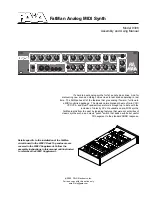
2. OVErVIEW
|
7
Keyboard Section
The keyboard section consists of the keyboard, modulation
wheel, pitch stick and various keyboard related buttons.
Please refer to page 10 for more information.
LCD Window
The LCd
window is
normally used
for displaying
the current
program
bank, num-
ber, name and category.
When operating a knob or button the associated param-
eter name and setting will breifly show in the LCd window.
The LCd window is also used for displaying the System
menu or MIdI menu.
System Menu
The System Menu is used for editing system specific
parameters. You access it by pressing the
sYsteM
button
(
shift + sLOt a
).
Please refer to page 31 for more information.
MIDI Menu
The MIdI Menu is used for editing MIdI specific settings.
You access it by pressing the
Midi
button (
shift + sLOt B
).
Please refer to page 29 for more information.
MIDI LED indicator
The
Midi Led
will indicate incoming
MIdI note messages by briefly lighting
up.
About knobs
Master LeveL
knob
The
Master LeveL
knob controls the
overall amplitude for all audio out-
puts, including line level outputs and
headphone output. The
Master LeveL
knob’s physical position is always the
same as the output level.
LCD-dial
The LCd-dial is used for
changing the current set-
ting displayed in the LCd
window. If not in the System
or MIdI Menu, this means
loading a new program.
The dial is endless, though
the array of parameter
settings are not; once you
reach the first or last pos-
sible setting, turning the
dial further will have no
effect.
The dial has an accelerator feature; when operated swiftly
increasment/decreasment will be made in larger intervals.
If only one setting is available, turning the knob will
F
have no effect.
LED-dials
The dials have a LEd window to
show their parameter setting.
When operating the dial the cur-
rent setting is also shown briefly
in the LCd window.
The dials themselves are endless,
though the array of parameter
settings are not; once you reach
the first or last possible setting,
turning the dial further will have
no effect. The LEd window will
update automatically when loading a program.
If only one setting is available (for instance if you
F
have only 1 sample in memory), turning the dial will
have no effect.
Potentiometer knobs
Potentiometer type knobs have a fixed
range with start and end positions. The
knobs position is physically indicated
which make them convenient as you
instantly ‘feel’ the knobs position and
can easily operate the knob without
looking.
Note when loading a program; a parameter value can
F
be totally different from the knob’s physical position.
As soon as you start turning the knob the parameter
value will ‘snap’ to the knob’s physical position.
Most potentiometer type knobs have a green LEd indicator
below them. This LEd is used for indicating when a param-
eter is connected to a
MOrPh
source. Please refer to page
27 for more information on morphing.





























